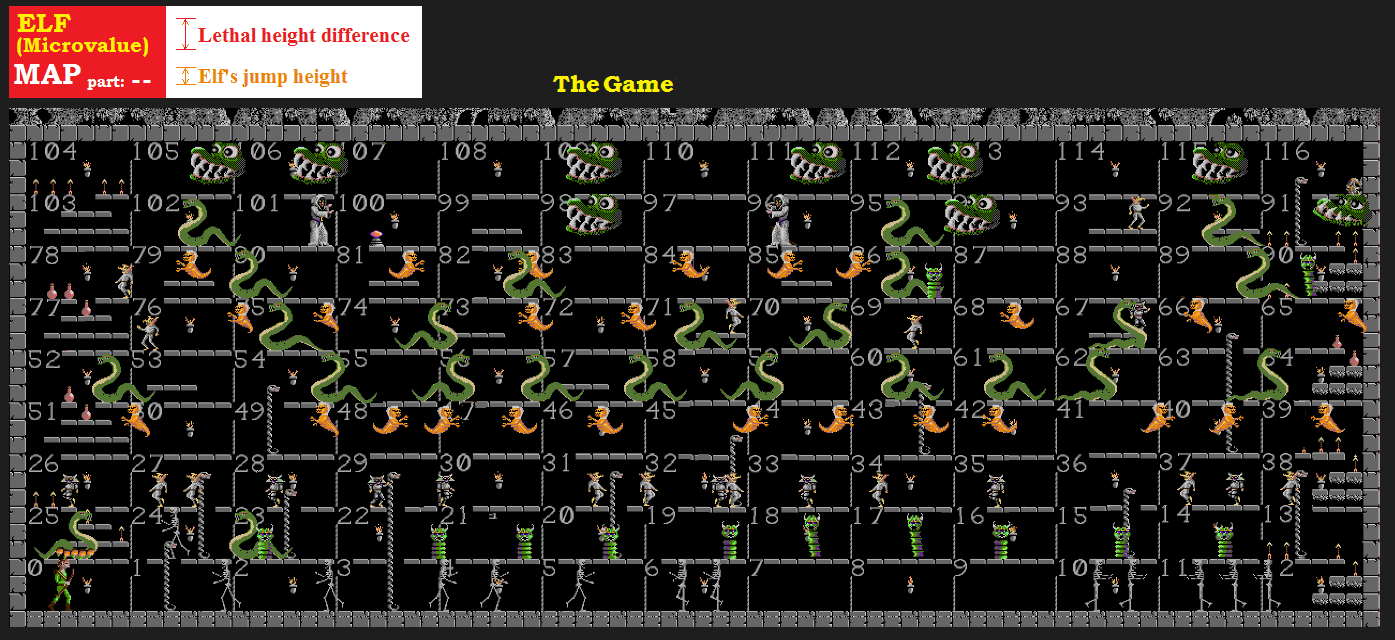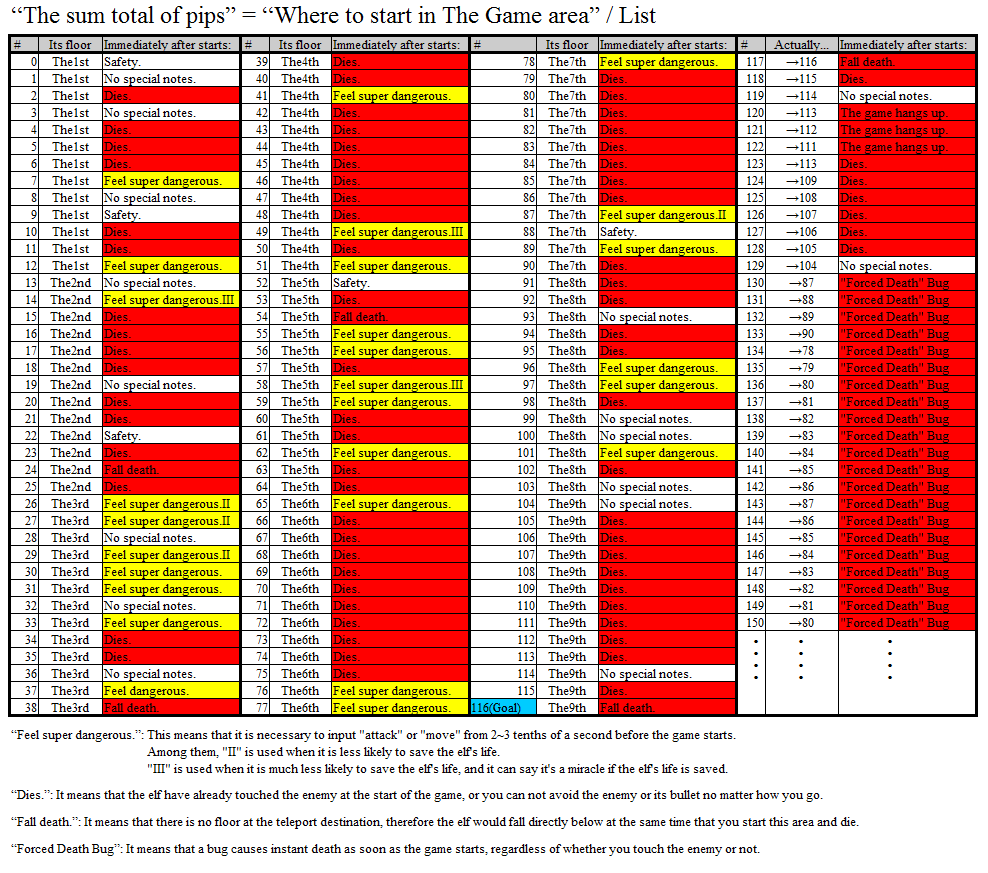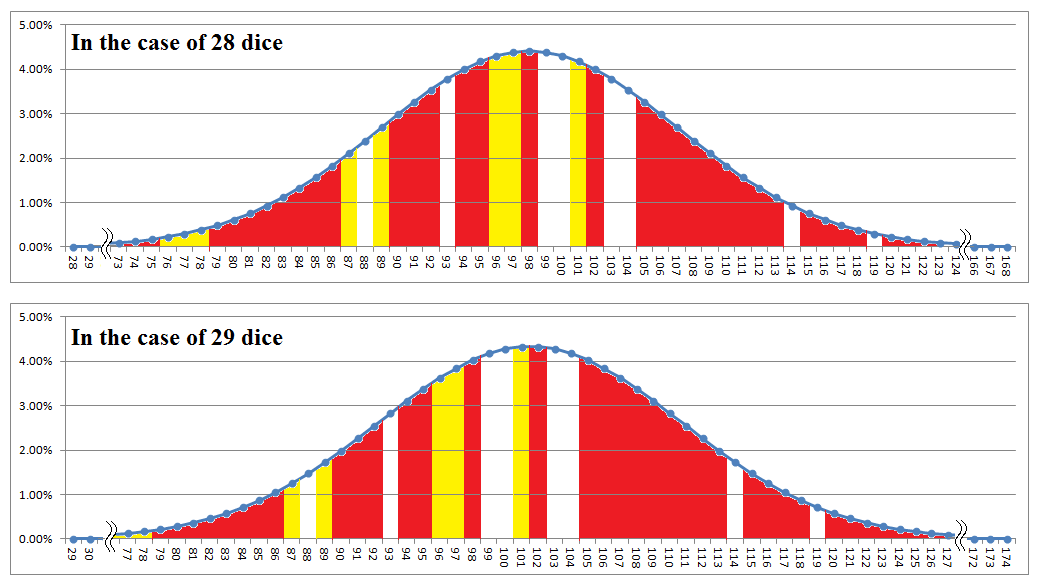At the end of the hell area you can reach from the final password point, you can get only one slice of pumpkin.
And another one is at the top of the "The Game" area, at the end.
This area is a special area that is not directly connected to any of the previous areas, but can be reached from anywhere with any timing.
It is also a place where it will be forced to end within the time limit of "60 seconds (in the real world)" even if the elf has enough food.
When you press the "G" key on any timing, you will be asked "Use dice?"
Next, you can teleport to "The Game" area by pressing the "Y" key or another key.
There are only three ending conditions for this area.
• The elf dies (touching enemies or bullets).
• The elf's food becomes zero and starves to death.
• “60 seconds (in the real world)” has passed since you come to this area.
After this area ends,
the elf's parameters at the end of this area and the enemy information of this area (which enemies were defeated and where enemies went to) will be inherited,
and the area will resume from the beginning before you came to this area.
By the way, you can come to this area "anytime" and "as many times" as you want afterwards by pressing the "G" key.

Well... have you noticed?
Dice that are placed everywhere on the vast main map, and the meaning of the "sum total of pips" displayed at the bottom of the screen.
If you collect one dice, one of "1" to "6" will be acquired randomly.
The “sum total of pips” on dice you've collected is used at the start of this area.
When asked "Use dice?" and whether or not you press "Y" key, it means that you should be selected from "use all" or "use none" about "sum total of pips".
When used, you teleport to the same number as the "sum total of pips" and start this area.
For example, if your current the "sum total of pips" was 56 and you used them, you will start at the foot of the dial "56" on the map (by the way, you can walk on the dial).
The enemy placement of the map created by this website faithfully reproduces the initial position when entering the area for the first time.
Therefore, even if there is an enemy at a position that is not on the map created by this website (closer to the player) when you scroll the map,
you should remember it with experience after dying.
As you've probably figured out by now, the real problem isn't that trivial.
"Thankfully it starts in the middle / latter of the area, but if there's an enemy in there, you're out of the game immediately!" We are talking about.
This is also originally you should learn to do one by one every dying, however, see following list I made, and save your time!

The first thing every person thinks about is, "Can't I just start at the final password point, get some dice, and head to the final areas group?".
No wonder.
We want to avoid the worst that a password system doesn't make sense if possible.
A pip when picking one dice is random, and if the number of dice is limited in the first place,it is necessary to verify whether or not that wish is fulfilled.
Elucidating the detailed algorithm is meaningless because it is impossible to "aim" in actual play.
Rather, it should be considered in the general theory of probability.
As for the "sum total of pips" when the dice are rolled n times, the larger n is, the closer the result is to the normal distribution.
On this website, the average sum total of pips of n dice is “3.5×n”, its variance is “(3.5×n)×(5/6)”, and its standard deviation is the square root of the variance.
"Probability" for each "sum total of pips" is estimated.
First of all, the total number of dice that can be obtained in the final areas group is “17”.
In this case, the "sum total of pips" is as follows.
The horizontal axis represents the “sum total of pips”, and the vertical axis represents the probability of doing so.

Mostly, it will fit between "50" and "60".
The coloring of the graph corresponds to the color of the risk level list.
Even though it feels super dangerous at the starting, the chances of instant death without question may be relatively low.
However!
"50" or "60"... (lol) After starting of this area from the 5th floor, you may be able to reach the 7th floor even if you're the best.
In short, I don't have enough time. 60 seconds...it's so quick.
By the way, there are 9 dice in "Stairs" area, which is very close to "Yard" area.
Since they are at the bottom of the area where crocodile-faced strong enemies are,
some people may have ignored them and picked up only weapons and returned to "Yard".
Although we have to consume the weapon to defeat both of crocodile-faced enemies,
if you also pick up 9 dice here and graph the "sum total of pips" with a total of 26 dice as follows:

It's easy to imagine that you can start from a position far ahead of the "17 dice" case even without drawing a graph, but now let's focus on the coloring.
The area of red is increasing.
Anyone who plays this game know painfully how difficult it is that the final dice in the final areas group becomes the 26th dice.
However, there is a high possibility of that pain may not be rewarded, isn't there?
However, there are white and yellow zones at the right foot of this normal distribution, so you wanted a little more dice, I guess.
Then why don't you work hard more a little (crying) and try to get 6 dice in "Tombs" area?
When you get to this point, you can also gain number of magic / food by going to "Shaft" via "Network".
If you also pick 6 dice up in "Tombs", the final dice in the final areas group will be the 32nd.
You can see the total number of dice can be adjusted in the final areas group!
Then there is room for desire.
In other words, the starting point of "The Game" should be as close as possible to the top floor, and the probability of instant death at the starting is the lowest.
We want to find the optimal solution for that.
It is "28 dice" or "29 dice". (See graph below)

It's easy to say...
(It is not necessary to tell if you have read up to this point.) Also note that it is not better that "the more it is, the better".
For your reference,
the following is the optimal solution for the "sum total of pips =114" (which is "the number we want" as the "ideal starting" if possible).

It would be great if we could start from point "114", but the risk would be too big.
Almost all are red.
The probability of becoming "114" when taking 33 dice is 4%, the probability of becoming "119" is less than 4%, and even if two patterns are combined, it does not go 8%.
You guys can't bet, can you?
The runner-up is "32 dice", which is the maximum number of dice for players who return to "Tombs".
The normal distribution is just a slight shift of the above graph along the horizontal axis to the left, so it is still a high risk of aiming for "114" one point.
And, the more the dice are collected over "33", the more the normal distribution in the above figure shifts to the right along the horizontal axis, so the red zone increases even more.
It is obvious that it is useless if there are too many dice.
The conclusion is that it's not worth going back to "Walkway" to get another 10 dice, in theory.
In the first place, the "sum total of pips" displayed at the bottom of the screen is a 2-digit number. It would have been great if the maximum value was "99".
Not really, it's just that the third digit is hidden.
You can see a hole at the "116" point and feel despair after the "130" point,
and you never complete the game unless you conquer such an area, which can only be thought of as a block of malice. Aaaggghhh...
>>Return to the "ELF" main page
>>Return to the "TOP 9 of the Hardest Platformers in any Amiga" page